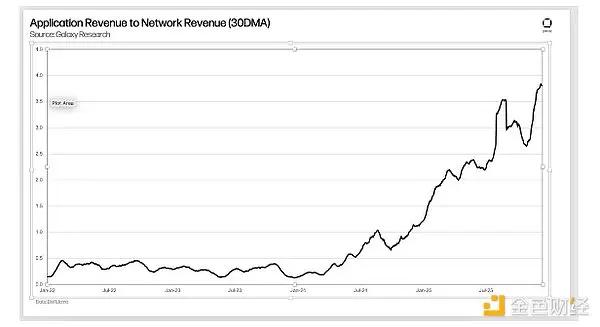Title: First Principles - Compounders, L1s, IR, Buybacks
Author: 0x kyle__, member of DeFiance Capital
Translated by: ChatGPT
Editor's Note: The author believes that the biggest problem in the crypto industry is not talent or capital, but the lack of first principles thinking, which has led the industry into a cycle of short-termism, extractive culture, and low integrity. The author analyzes the reasons why compounders are difficult to emerge, proposes the need to drive long-term thinking from the top and focus on building revenue-generating products, criticizes the inefficiency of generic Layer 1 blockchains, and suggests they should focus on specific domains and build their own ecosystems to give their tokens value. The author also emphasizes that liquidity token projects should establish an investor relations role to enhance transparency, rather than relying solely on buybacks and burnings, and advocates using funds to expand products and strengthen long-term competitive advantages to break the current nihilism and achieve sustainable growth.
The following is the content of the original text (with some editing for better readability):
The biggest problem in this field is not talent or capital. Simply put, it is the lack of first principles thinking. This is a culture that must change. That 1% of people need to start pushing this field forward.
If you've been following my Twitter recently, you'll find that I've been shouting about some extremely low-hanging fruit that seem to have high leverage, look very easy to achieve, but apparently no one "understands" or executes well. Here are some of the views I've expressed:
The real problem is: why don't more chains use their grant programs to incubate their own dapps, and build dapps that are clearly aligned with the chain? Instead of hoping these dapps won't abandon the chain in two years.
The reason this industry has the current price trajectory is largely because everyone has the mindset of "you have to sell because one day it will go to zero". The reason is that no one has really built good products that people want to keep DCAing into. Crypto needs compounders.
The "marketing" in crypto is mostly misaligned with the product in most cases. If you're not a consumer-facing product - say you're a yield platform, why are you even marketing to retail users at all. The best marketing is often price appreciation. And the ones who are best at this are liquidity funds.
I will discuss each topic in this article, namely:
Compounders, culture, short-termism
Generic L1s are dead, must change
Liquidity tokens and investor relations
Buybacks and burnings are the least bad, not the best
I've titled this "First Principles" because all these views are things I came up with through a simple thought exercise of how to use common sense to change the industry today.
It's not rocket science. Insanity is doing the same thing over and over again and expecting different results.
We've been through three cycles, doing the same thing over and over again - essentially creating a nihilistic, zero-value accrual, maximum token and app extraction, because for some stupid reason we decided to open a casino every four years, attracting capital from around the world to gamble.
Guess what? After three cycles, ten years later, people finally realize that the house, the scammers, the manipulators, the ones selling you overpriced food and drinks in the casino, are taking all your money. The only thing you can show for your months of hard work is how you wiped out your entire history on-chain. An industry built on the premise of "I'll come in, make my money, and then leave" will not lead to the establishment of any long-term compounders.

This place used to be better, used to be a place of legitimate financial innovation and cool technology. We used to get excited about novel and interesting applications, new technologies, "changing the future of (finance) in France".
But due to extreme short-termism, maximum extraction culture, and low-integrity people, we've fallen into this perpetual financial nihilism self-cannibalization cycle, which collectively self-triggers when everyone thinks constantly pumping random scammer tokens is a good idea because "I'll sell before they scam me". (Seriously, I've seen people say they know the "SBF tokens" are a scam, but they'll sell to "quickly profit" before getting rugged.)
You can say I don't have building experience - that's true. But this is a small field, and it hasn't been around for long; working in this field for four years, while collaborating with some of the best and brightest funds, has given me a deep understanding of what works and what doesn't.
Again, insanity is doing the same thing over and over again and expecting different results. As an industry, we've gone through the same thing year after year - feeling this nihilism after the inevitable price collapse, thinking it's all worthless. I felt this way when NFTs crashed (oh god, it's all a scam), and now people feel this way after the recent meme coin debacles, just as they did in the ICO era.
Changing the status quo is simple: we just need to start doing different things.
Compounders, Culture, Short-Termism
Compounders are simply assets that go up over a multi-year time frame and don't go down - think Amazon, Coca-Cola, Google, etc. Compounders are companies with the potential to achieve sustainable and long-term growth.
Why haven't we seen compounders in crypto?
The answer is more nuanced, but essentially - extreme short-termism and misaligned incentives. Yes, there are a lot of issues with the structure of incentives, Cobie's private capture, phantom pricing article covers this well. I won't delve into this, as the focus of this piece is what can we as individuals actually do now?
For investors, the answer is obvious - Cobie points out here: you can opt out (and you probably should)

Indeed, people have opted out: we've seen the decline of "CEX tokens" this cycle, as retail participants choose not to buy these tokens; while individuals may not have the ability to change this systemic issue at the system level, the good news is financial markets are quite efficient - people want to make money, and when the existing mechanisms don't make money, they don't invest, making the whole process unprofitable, thereby forcing the mechanisms to change.
However, this is just the first step - to truly build compounders, companies need to start instilling long-term thinking in this space. It's not just that "private market capture" is bad, but the entire chain of thought that led us to this point - like a self-fulfilling prophecy, founders seem to collectively believe "I'll make my money and then leave", with no one truly interested in playing the long game - which means the charts always look like the McDonald's M.
The top must change: a company is only as good as its leaders. Most projects fail not because of a lack of developers, but because the leadership decides to leave. This industry must start to see those high-integrity, high-agency, long-term thinking founders as the role models, rather than the idealized "short-term pump and dump" founders.
The average quality of founders in this space is not news. After all, this is an industry that calls people who are just binding pumpfun tokens "developers" - the bar is really not that high. As long as you have a vision that goes beyond the first two months of token launch, you're already ahead of the pack.
I also believe the market will start to economically incentivize this long-termism, and we're starting to see that. Despite the recent selloff, Hyperliquid is still up 4x from the initial listing price, which is something very few projects this cycle can boast about. When you know the founders' long-term growth is aligned with the product, it's usually easier to make the "long-term hold" argument.
Here is the English translation of the text, with the specified terms preserved and not translated:The natural conclusion is that founders with high integrity and high agency will start to occupy the majority of the market share, because frankly, when everyone is tired of scams, they just want to work for someone with a vision who won't exit the scam - and there are just too few of those people.
Besides having a good leader, the establishment of compounding also depends on the assumption that the product is good. In my view, this problem is easier to solve than finding a good founder. The reason there are so many meaningless products in the crypto space is that the people creating these meaningless products also have the mindset of "make money and leave" - they therefore choose not to take on new problems, but only to fork popular things and try to make money from them.
However, the reality is also that this industry does choose to reward these meaningless ideas - like the AI agent hype in Q4 2024. In this case, once the dust settles, we will see the usual McDonald's M-shaped pattern - so companies also need to start focusing on building revenue-generating products.

No revenue path = no long-term believers/holders = no buyers of the asset, because there is no future to bet on.
This is not an impossible task - crypto businesses do make money. Jito has $900 million in annual revenue, Uniswap $700 million, Hyperliquid $500 million, Aave $488 million - in the bear market, they continue to make money (just not as much).

Looking ahead, I believe the fleeting, narrative-driven speculative bubbles will become smaller and smaller. We've already seen this - in 2021, gaming and NFT valuations were in the trillions, but this cycle, the peak of memes and AI agents is only in the tens of billions. This is a macro-level euthanasia roller coaster.

I believe everyone should be free to invest in what they want. But I also believe people want their investments to generate returns - when games so clearly signal "this is a hot potato, I have to offload it before it goes to zero", the roller coaster will get faster and the market size will get smaller, as people choose to exit, or lose all their money.
Revenue solves this problem - it lets you as an investor understand that people are willing to pay for the product, and therefore have a certain long-term growth prospect. When something has no revenue path, it is almost uninvestable on a long-term basis. On the other hand, a revenue path leads to a growth path, attracting buyers who are willing to bet on the asset continuing to grow.
In summary, building compounding requires:
Instilling long-term thinking at the top
Focusing on building revenue-generating products
The Generalist L1 is Dead, Change is Needed
If you sort the Coingecko homepage by market cap, you'll find that blockchains occupy more than half of it; aside from stablecoins, Layer 1s occupy a huge amount of value in our industry.

However, the chart of the second largest digital asset after Bitcoin looks like this:

If you bought in July 2023, at current prices, you would be up 163%.
If you bought in July 2023, at current prices, you would be up 0%.
This is not even the worst part. The 2021 bubble frenzy spawned a wave of "Ethereum killers" - new blockchains aiming to surpass Ethereum in some technical way - whether it's speed, development language, block space, etc. But despite the hype and massive capital inflows, the results have not lived up to expectations.
Today, four years on, we are still dealing with the aftermath of that wave - on Coingecko there are 752 smart contract platforms that have launched tokens, and likely many more that haven't.

Unsurprisingly, most of their charts look like this - making Ethereum's chart look relatively good in comparison:

So - despite four years of effort, billions of dollars in capital, 700+ different blockchains, only a handful of L1s have decent activity - even those haven't reached the "breakthrough user adoption levels" that everyone expected four years ago.
Why? Because most of these projects were built on the wrong premise. As Luca Netz pointed out in his article "What is Consumer Crypto", many of today's blockchains follow a generalist approach, each blockchain dreaming that they will "host the internet economy".

But this requires massive effort, ultimately leading to fragmentation rather than penetration, because a product trying to do everything usually can't do anything well. It's an effort that costs too much money and time - frankly, many blockchains can't even answer a simple question: "Why should we choose you over blockchain #60?"
The L1 space is another case of everyone following the same script but expecting different results - they compete for the same limited developer resources, try to outdo each other on funding, hackathons, developer housing, and now we seem to be making phones (?).
Let's assume an L1 succeeds. Every cycle, some L1 breaks through. But can that success be sustained? The success story this cycle is . But here's a take that many of you may not like: what if becomes the next Ethereum?
Last cycle, there was a group of people so convinced of Ethereum's success that they put the majority of their net worth into Ethereum. Ethereum is still the highest TVL chain, and now even has an ETF - yet the price is stagnant. This cycle, the same type of people are saying the same thing - is the chain of the future, ETF, etc.
If history is any indication, the real question is - can today's victories guarantee relevance tomorrow?
My view is simple: rather than building generalist blockchains, L1s should build around a core focus. Blockchains don't need to be all-powerful for everyone. They just need to excel in a particular domain. I believe the future is blockchain-agnostic - it just needs to perform well, and the technical details won't matter as much.
Today, builders are already showing signs of this - founders building D-apps are primarily focused not on the chain's speed, but on the chain's distribution and end-user adoption - does your chain have people using it? Does it have the necessary distribution to make the product compelling?
44% of web traffic runs on WordPress, but its parent company Automattic is only valued at $7.5 billion. 4% of internet traffic runs on Shopify, but it's valued at $120 billion - 16x Automattic! I believe L1s will have a similar end state, where value will accrue to the applications built on the blockchains.
To this end, I believe L1s should take disruptive measures and build their own ecosystems. If we analogize blockchains to cities (thanks to Haseeb's 2022 article), we can see that cities start because of specific advantages that make them viable economic and social hubs, and then over time focus on a dominant industry or function:
Silicon Valley → Tech
New York → Finance
Las Vegas → Entertainment & Hospitality
Hong Kong and Singapore → Trade-centric financial hubs
Shenzhen → China's hardware manufacturing and tech innovation center
Paris → Fashion, art, and luxury
Seoul → K-pop, entertainment, and beauty industry






